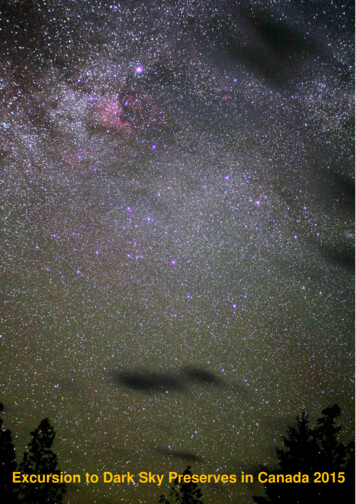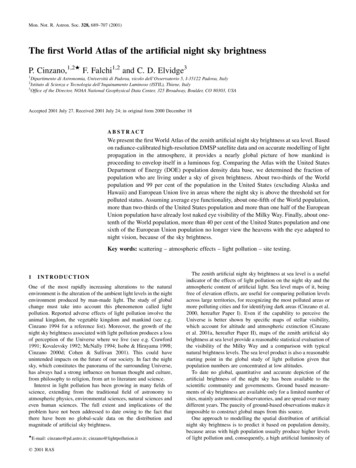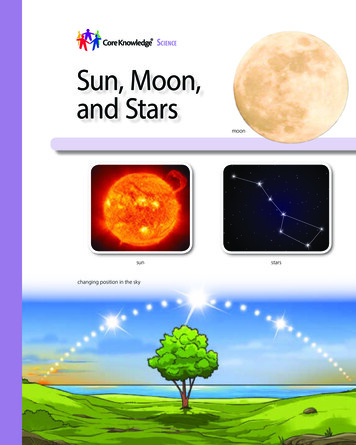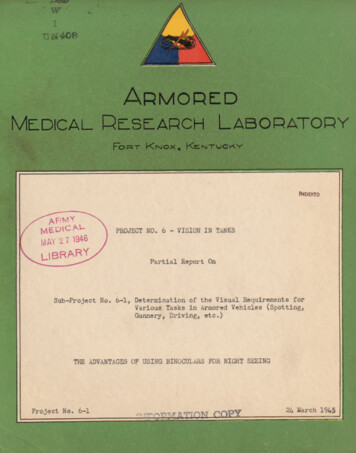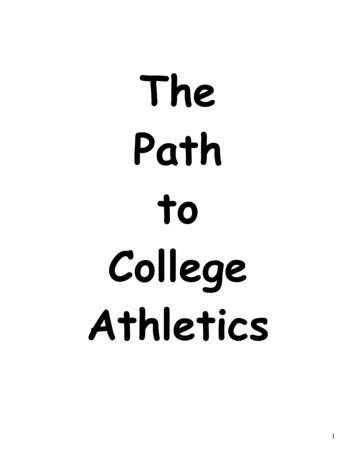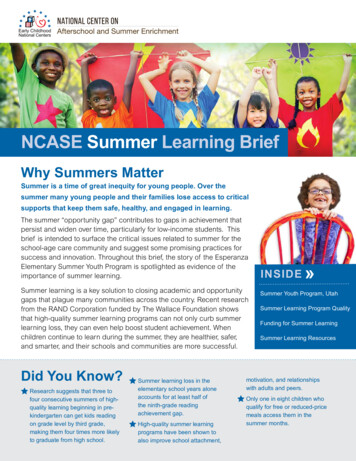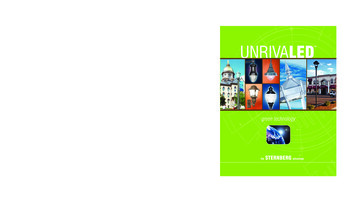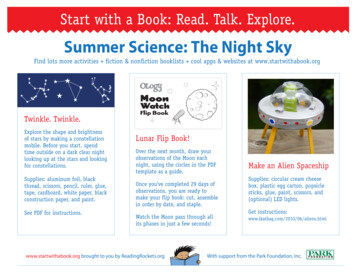
Transcription
Start with a Book: Read. Talk. Explore.Summer Science: The Night SkyFind lots more activities fiction & nonfiction booklists cool apps & websites at www.startwithabook.orgTwinkle. Twinkle.Explore the shape and brightnessof stars by making a constellationmobile. Before you start, spendtime outside on a dark clear nightlooking up at the stars and lookingfor constellations.Supplies: aluminum foil, blackthread, scissors, pencil, ruler, glue,tape, cardboard, white paper, blackconstruction paper, and paint.See PDF for instructions.Lunar Flip Book!Over the next month, draw yourobservations of the Moon eachnight, using the circles in the PDFtemplate as a guide.Once you've completed 29 days ofobservations, you are ready tomake your flip book: cut, assemblein order by date, and staple.Watch the Moon pass through allits phases in just a few seconds!www.startwithabook.org brought to you by ReadingRockets.orgMake an Alien SpaceshipSupplies: circular cream cheesebox, plastic egg carton, popsiclesticks, glue, paint, scissors, and(optional) LED lights.Get th support from the Park Foundation, Inc.
Start with a Book: Read. Talk. Explore.Summer Science: The Night SkyFind lots more activities fiction & nonfiction booklists cool apps & websites at www.startwithabook.orgMyth MakerWrite your own modern-day mythinspired by a constellation. Whenthe story is complete, plan a nighttime read aloud under the stars!See PDF for instructions.Moon CookiesCool Apps and WebsitesEach month, the Moon passesthrough different phases, growingfrom New Moon to Crescent to FirstQuarter to Gibbous to Full andthen back again. Learn about theeight phases of the Moon usingOreo cookies!APPS The Night Sky Skyview: Explore the Universe Britannica Kids: Solar System Redshift AstronomySee PDF for instructions.www.startwithabook.org brought to you by ReadingRockets.orgWEBSITES NASA Kids Club Sizing Up the Universe Astronomy: Our Place in SpaceWith support from the Park Foundation, Inc.
Start with a Book: Read. Talk. Explore.Summer Science: The Night SkyFind lots more activities fiction & nonfiction booklists cool apps & websites at www.startwithabook.orgFiction BooksNonfiction BooksHer Seven Brothers by Paul GobleA is for Astronaut: Exploring Space from A to Z by Traci ToddHow the Stars Fell Into the Sky: A Navajo Legendby Jerrie OughtonFind the Constellations by H.A. ReyThe Lost Children by Paul GobleThe Love of Two Stars by Janie Jaehyun ParkThe Milky Way: A Cherokee Tale by Joseph BruchacA Full Moon Is Rising by Marilyn SingerI, Galileo by Bonnie ChristensonLook Up! Henrietta Leavitt, Pioneering Woman Astronomerby Robert BurleighMousetronaut: Based on a (Partially) True Storyby Mark KellyThe Moon Book by Gail GibbonsThe Star People by S.D. NelsonOur Stars by Anne RockwellStarry Tales by Geraldine McCaughreanThe Sky Is Full of Stars by Franklyn BranleyWhere the Mountain Meets the Moon by Grace LinStargazers by Gail GibbonsOnce Upon a Starry Night by Jacqueline MittonStars by Seymour SimonThanking the Moon by Grace Linwww.startwithabook.org brought to you by ReadingRockets.orgWith support from the Park Foundation, Inc.
CREATIVE ACTIVITY : STARSstwinkle, twinkleStars look pointy and seem to twinkle because we see them through the layers of the atmosphere — the gasses thatsurround our planet. The movement of air and dust in the atmosphere bends (refracts) a star’s light in different directions.Because the light is scattered by the time it reaches our eyes on Earth, stars appear to twinkle.Even though stars do not twinkle or have points, these huge, hot balls of gas do shine. In this craft activity, your child willexplore the shape and brightness of stars and constellations by making a mobile.Supplies Aluminum foil Black thread Scissors, pen or pencil, ruler, glue, and tape Cardboard (at least 8 x 11 ½ inches in size) White paper Black construction paper and paintGetting StartedIn his book Find the Constellations, author H.A. Rey explains why some stars appear brighter than others. Talk with your childabout the brightest star of all — our sun — and ask her why she thinks stars in the night sky seem smaller and much lessbrighter.Because stars are very far away, they look small to us. They may also appear less bright because of a difference in distanceor a difference in size. If you can, spend time outside on a dark clear night looking up at the stars. See if you can findthe Indian girl and her seven brothers from Paul Goble’s Her Seven Brothers in the Big Dipper. (The Sky Views in Find theConstellations can help you find these stars.)To bring the stars inside, have your child select a constellation from the book you’ve read. Talk with her about the starsin her selection. Are they very bright or of a lesser magnitude — the measure of a star’s brightness? How are the starsarranged? What does she like about the shape of the constellation?As you discuss, have her cover the cardboard with a piece of black paper and glue it in place. Then let her draw theconstellation or trace it from the book onto white paper. Then place the tracing over the black-covered cardboard and usethe pencil or pen to poke holes into the cardboard where she’s drawn the stars. Now that her constellation is in place, shecan surround it with more stars using drops of white or silver paint.Adventures in Reading: Family Literacy Bags from Reading Rockets
CREATIVE ACTIVITY : STARSstwinkle, twinkleWhile the paint dries, have your child measure and cut lengths of thread about 2 feet long. She’ll need a thread for eachhole she’s poked in the cardboard. She will also need a square of aluminum foil to make a star for each thread. She canmake her stars as large as she likes, but foil squares should be at least seven inches.Have her tape a thread in the center of an aluminum foil square. Then have her squeeze and shape the foil into a ballaround the end of the thread. It’s a bright, round star!When all her stars are ready, help her pull the end of a thread through each of the poked holes in the cardboard. Tapethe thread to the back of the cardboard to secure it in the “sky.” You and your child may want to review the constellationchart as you pull threads through, making some of the threads shorter for stars that are less bright or squeeze the foil eventighter to make the stars smaller for stars that seem smaller.Hang the mobile on the ceiling with tape or tacks. Have your child lie under it. Can she find the picture in herconstellation?Adventures in Reading: Family Literacy Bags from Reading Rockets
Dates of ObservationMoonWatchFlip ther:Weather:Comments:Comments:
r:Comments:Comments:
r:Comments:Comments:
IMAGINATION ACTIVITY : STARSsstellar authorAll around the world, people have been telling stories about the stars in the sky for thousands of years. Some of thesetales were created to help explain how the stars appeared. Her Seven Brothers by Paul Goble is actually a retelling of theCheyenne legend about the creation of the stars in the Big Dipper.Other stories were created because people long ago who studied the night sky saw shapes and patterns among the starsand made up stories to describe what they saw. The same groups of stars were seen differently by people from differentparts of the world. In this writing activity your child will compare her imagination with stargazers from ancient times.Supplies Paper and pencil Sky view charts or star maps (from your books or the Internet)Getting StartedTalk with your child about what a constellation is and how these manmade groupings of stars help make it easier to recognize which staris which. During your reading, you and your child may have alreadydiscussed that some constellations look like what they are supposed torepresent but many do not.Many of the constellations take names and have stories from Greekand Roman mythology. If your child is not familiar with mythology, talkwith her about some of these myths and mythological creatures, suchas the Centaur, Hydra, and Pegasus.Look together at the stars on your chart. What kinds of patterns doesyour child see? Ask her to find a cluster of stars and design a newconstellation with its own modern-day myth. Ask her to draw herconstellation first. While she’s drawing, you may want to remind herthat a myth is a story that tries to explain how something came to beand often involves a hero or heroine. Her constellation myth shouldexplain how and why her particular constellation is in the sky.When her myth is complete, plan a nighttime read aloud of her starry tale outside under the stars!Look for more titles about Stars in a library near you: 6304.Extra ResourcesThis website provides mythology and more on all the constellations:http://starryskies.com/The sky/constellations/index.htmlWant to make more constellations? Try this interactive from PBS: entures in Reading: Family Literacy Bags from Reading Rockets
Oreo Moon PhasesDuring a month, the part of the Moon that we see in the sky changes shape. Itpasses through different phases, growing from New Moon to Crescent to FirstQuarter to Gibbous to Full, and then decreasing in the amount that we see fromEarth that is illuminated until it is back at New Moon again. Each of these stagesis a “phase.” Invite your child to create the 8 phases of the Moon using Oreocookies.In this activity, you and your child will learn about the Moon’s phases using Oreocookies!What You Need:4 Oreo cookiesPaper towelPlastic knife, spoon or popsicle stickPhrases with Phases song sheetWhat to Do:Twist open the Oreo cookies and remove the cream with the knife, spoon orpopsicle stick so that it looks like the pictures below.Place the cookies in order in a line to represent the order of our Moon’sphases.Point to and name the different phases with your child while singing theMoon phase song – Phrases with Phases.Lunar Parent Prompts:What are the different phase names – can you place them in order?What phase is the Moon in tonight?How does the Moon’s appearance change?Which phase will the Moon change to next?Copyright by the Lunar and Planetary Institute, 2008LPI Contribution Number 1463http://www.lpi.usra.edu/education/space days
Phrases with PhasesLyrics by Becky Nelson, The Lunar and Planetary InstituteSung to the tune The Ants Go Marching . . Moon phases and important terms are in capital letters.Each Moon phase marches COUNTERCLOCKWISE —Now, let’s start . . .The FIRST PHASE is the NEW MOON that we see as DARK.Then next the WAXING CRESCENT shinesA LITTLE LIGHT upon the RIGHT,And after that’s theQUARTER MOON, where theRIGHT HALF’S LIGHT.Following is WAXING GIBBOUS on the RIGHT,Where the LIGHT continues SPREADING and becoming bright.We’ll be HALFWAY through the phases soon,With the FULLest, brightest, biggest MOON,Just before the DARK creepsOn the RIGHTOf a WANING MOON.The WANING GIBBOUS phase is when the LIGHT will SHRINK,Then what will be the next phase after that, you think?It’s once AGAIN a QUARTER MOON,But the DARK HALF’s now upon the RIGHT,And the LEFT side is theOne’s that’s BRIGHT!!Did you get that right?The next phase is the LAST phase where there’s just a sparkOf light, so WANING CRESCENT appears ALMOST DARK!The Moon is really magical,When it’s WAXING, WANING, NEW OR FULL.And it COULDN’T SHINE at allWITHOUT .THE SUN’S .bright light!!Copyright by the Lunar and Planetary Institute, 2008LPI Contribution Number 1463http://www.lpi.usra.edu/education/space days
Lunar Flip Book! Over the next month, draw your observations of the Moon each night, using the circles in the PDF template as a guide. Once you've completed 29 days of observations, you are ready to make your flip book: cut, assemble in order by date, and staple. Watch the Moon pass through all its phases in just a few seconds!



